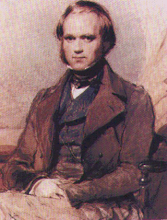
Darwin saved his most vivid and poetic language for his concluding paragraph. It is also the only place in the entire volume where a form of the word "evolve" is found (the contemporary term to describe the alteration of one species to another was "transmutation"):
It is interesting to contemplate an entangled bank, clothed with many plants of many kinds, with birds singing on the bushes, with various insects flitting about, and with worms crawling through the damp earth, and to reflect that these elaborately constructed forms, so different from each other, and dependent on each other in so complex a manner, have all been produced by laws acting around us…












